
Bio-ship Paladin, known in Japan as Space Battleship Gomora, is a 1990 horizontally scrolling shoot 'em up arcade game released by UPL and distributed by Sammy Corporation for North American manufacture. It was later ported to the Sega Mega Drive. While the game is essentially a standard horizontally scrolling shoot 'em up, it has an innovation that makes it unique in the genre. The player flies a spaceship which has the standard forward guns to be found in all horizontal scrollers, but it also possesses a weapon that can be manually targeted with a crosshair, in the same manner as in the game Missile Command. This allows the player to fire in any direction with pinpoint accuracy, and adds an extra level of strategy to the game. The game saw an almost arcade perfect port on the Mega Drive, albeit with a few changes that actually enhanced the look of the game such as added parallax scrolling backgrounds in the second level. It would eventually see a worldwide re-release as part of the Arcade Archives series for Nintendo Switch and PlayStation 4 on August 5, 2021.
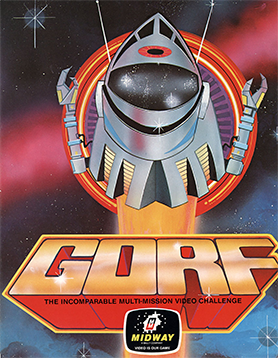
Gorf is an arcade video game released in 1981 by Midway Manufacturing, whose name was advertised as an acronym for "Galactic Orbiting Robot Force". It is a fixed shooter with five distinct levels, the first of which is based on Space Invaders and another on Galaxian. The game makes heavy use of synthesized speech for the Gorfian robot which taunts the player, powered by the Votrax speech chip. Gorf allows the player to buy two additional lives per quarter before starting the game, for a maximum of seven lives.

Tempest is a 1981 arcade game by Atari Inc., designed and programmed by Dave Theurer. It takes place on a three-dimensional surface divided into lanes, sometimes as a closed tube, and viewed from one end. The player controls a claw-shaped "blaster" that sits on the edge of the surface, snapping from segment to segment as a rotary knob is turned, and can fire blaster shots to destroy enemies and obstacles by pressing a button.
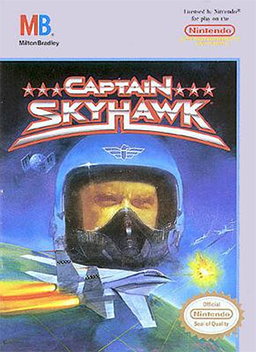
Captain Skyhawk is a scrolling shooter video game developed by Rare and published by Milton Bradley Company. The game was released in North America in June 1990 and in Europe the next year for the NES. It was also released for the PlayChoice-10 arcade machine.
Renegade Legion is a series of science fiction games that were designed by Sam Lewis, produced by FASA, and published from 1989 to 1993. The line was then licensed to Nightshift games, a spin-off of the garage company Crunchy Frog Enterprises by Paul Arden Lidberg, which published one scenario book, a gaming aid, and three issues of a fanzine-quality periodical before reverting the license.

Tyrian is a vertically scrolling shooter developed by Eclipse Software for MS-DOS and published in 1995 by Epic MegaGames. Tyrian was programmed by Jason Emery, illustrated by Daniel Cook, and its music composed by Alexander Brandon and Andras Molnar. The game was re-released as freeware in 2004. A free and open-source port of the game started in April 2007.

Full Thrust is a science fiction strategy wargame written by Jon Tuffley and published by Ground Zero Games of England. It is usually played with miniature figurines representing imaginary starships, although cardboard chits representing the vessels can also be used. Unlike many games, the publishers encourage the use of any miniatures rather than only "official" ones, though Ground Zero Games does also sell an extensive miniature range.

Solar Winds: The Escape and its sequel Solar Winds: Galaxy are top-down, space-themed role-playing action games developed by James Schmalz and published by Epic MegaGames in 1993.
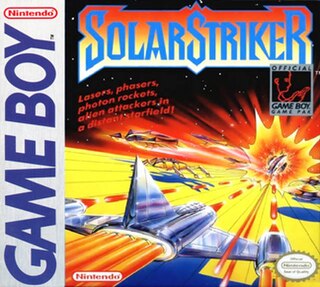
Solar Striker is a vertically scrolling shooter video game developed by Nintendo and Minakuchi Engineering and published by Nintendo for the Game Boy. It was first published in Japan on January 26, 1990, then released later in North America on February 2, and in Europe on September 28.
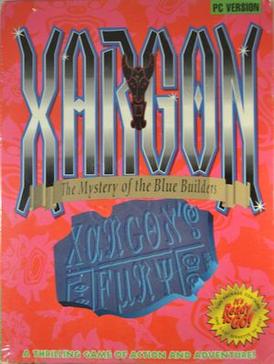
Xargon: The Mystery of the Blue Builders is a video game trilogy produced by Epic MegaGames for DOS. The game is a side-scrolling platform game. The main character, Malvineous Havershim, must journey through strange landscapes as he seeks to destroy the evil Xargon.

Silpheed is a video game developed by Game Arts and designed by Takeshi Miyaji. It made its debut on the Japanese PC-8801 in 1986, and was ported to the Fujitsu FM-7 and DOS formats soon after. It was later remade for the Sega CD and has a sequel called Silpheed: The Lost Planet for the PlayStation 2.

Metal Slug is a Japanese multimedia franchise and run and gun video game series originally created by Nazca Corporation before merging with SNK in 1996 after the completion of the first game in the series. Spin-off games include a third-person shooter to commemorate the 10th anniversary of the series and a tower defense game for the mobile platform. While originally created for Neo-Geo arcade machines hardware (MVS) and the Neo-Geo home game consoles (AES) hardware, the original games have also been ported to other consoles and mobile platforms throughout the years, with several later games created for various other platforms. The games focus on the Peregrine Falcon Squad, a small group of soldiers who fight against a rebel army, aliens, zombies, mummies and various other forces intent on world domination.
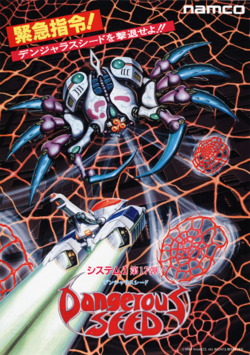
Dangerous Seed is a 1989 vertically scrolling shooter arcade game developed and published by Namco. Controlling one of three different starships, the player is tasked with destroying an alien race known as the Danger Seed before they wipe out all of mankind. Each ship has their own set of weapons and abilities, such as shots that dissolve enemies and target-seeking projectiles, and can sustain multiple hits before being destroyed. The player's ships can also combine into a new ship, the Moon Diver, featuring a stronger shield and additional weapons. It ran on the Namco System 1 hardware.

Acornsoft's Starship Command is a multidirectional shooter released in 1983 for the BBC Micro and Acorn Electron. It was available on cassette as well as 5.25" disc for the BBC and ROM cartridge for the Acorn Electron Plus 1 expansion module. The game was written by Peter Irvin who, along with Jeremy Smith, went on to create the arcade adventure Exile.

Major Stryker is a 2D vertically scrolling shooter video game written for DOS by Apogee Software. Its working title was "Strike Force" and was released in January 1993. It consists of three episodes, with the first episode distributed as shareware, and the rest available commercially. The three episodes are set on a Lava Planet, an Arctic Planet and a Desert Planet. The game was re-released as freeware on March 14, 2006, and on Steam with support for Microsoft Windows and macOS in 2014.

Section Z is a horizontally scrolling shooter by Capcom, released as an arcade video game in 1985. A home version was published for the Nintendo Entertainment System in 1987.

Bloodshot, also released as Battle Frenzy in Germany, is a video game developed by Jim Blackler for Domark in 1994 for the Mega Drive and the Mega-CD in Europe. A North American release was planned, and reviewed in gaming magazines, but was only released through the Sega Channel service.

Omega Fighter is a vertical scrolling shooter developed for the arcades by UPL and released in 1989. While similar to most other scrolling shooters, Omega Fighter was unique in its gameplay, level and enemy focus: rather than flying over multiple levels, the player faced up against an enormous space battle cruiser which contained every level. A Sega Genesis version was planned but never released.

Black Hole Assault is a fighting video game developed by Micronet co., Ltd. for the Sega Mega-CD in 1992. The game is the sequel to Micronet's Heavy Nova, though focusing entirely on Fighting Game elements.

Radix: Beyond the Void is a 2.5D first-person shooter developed by Canadian studio Neural Storm Entertainment and published by Epic MegaGames for MS-DOS in 1995.



















